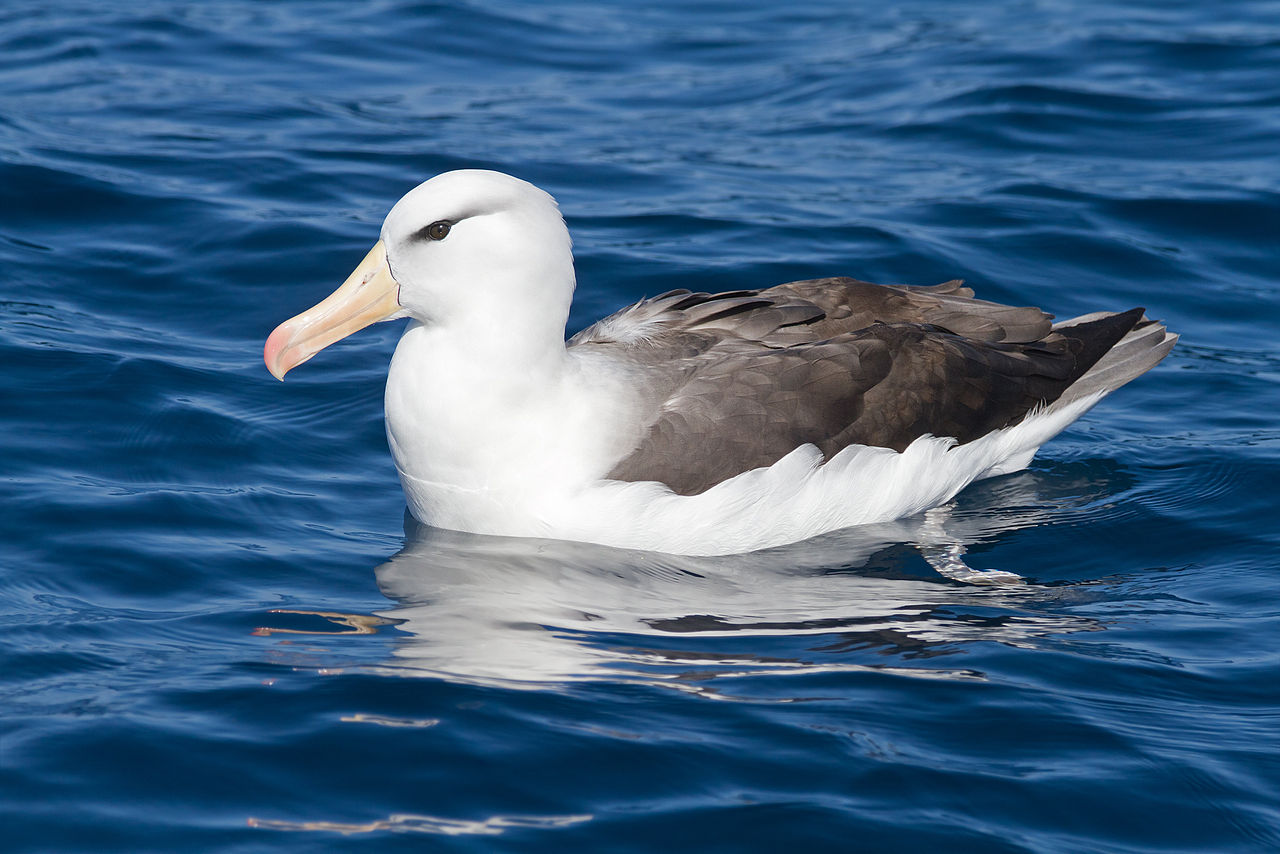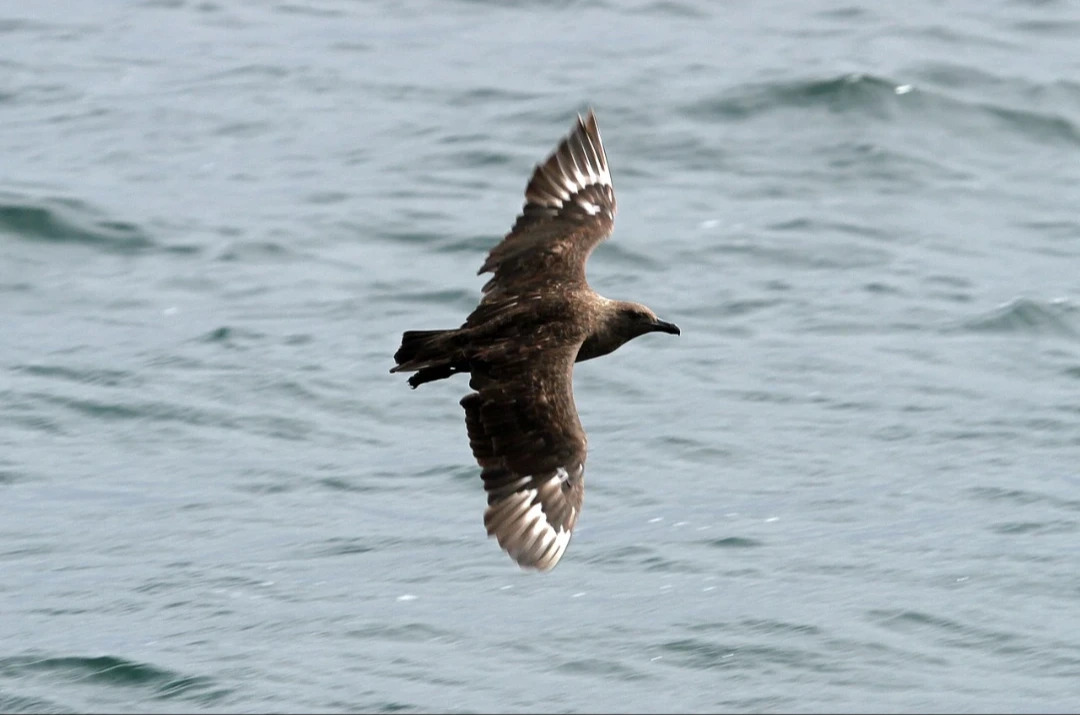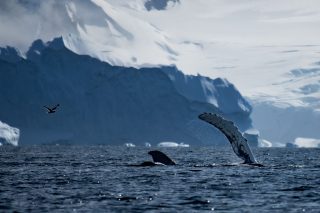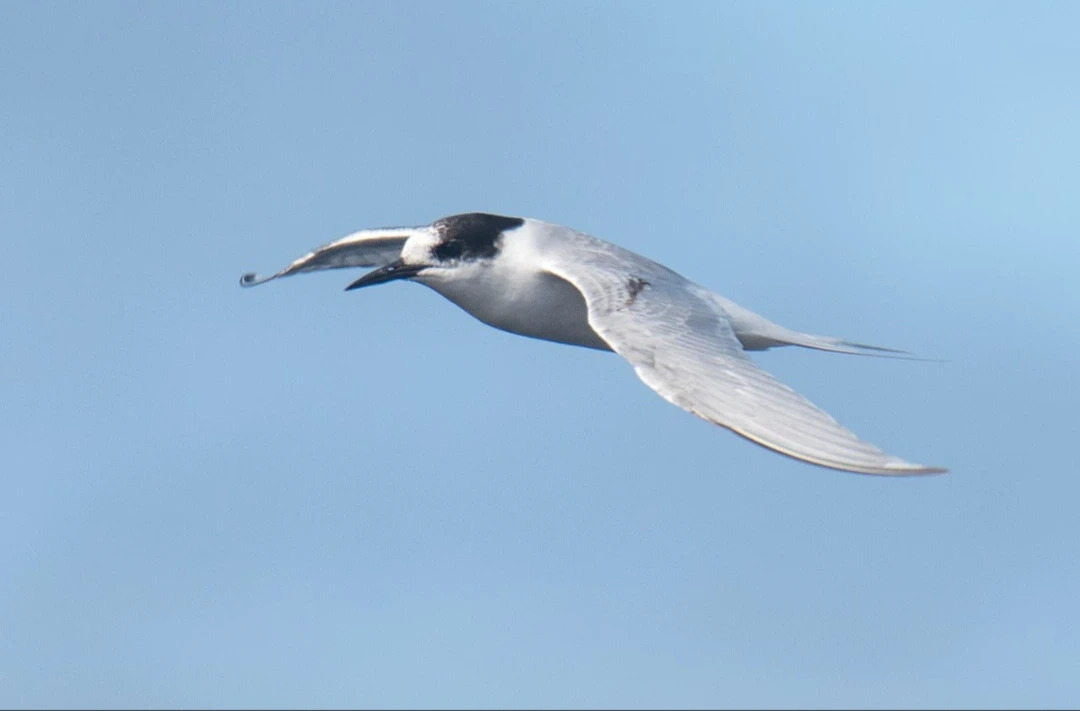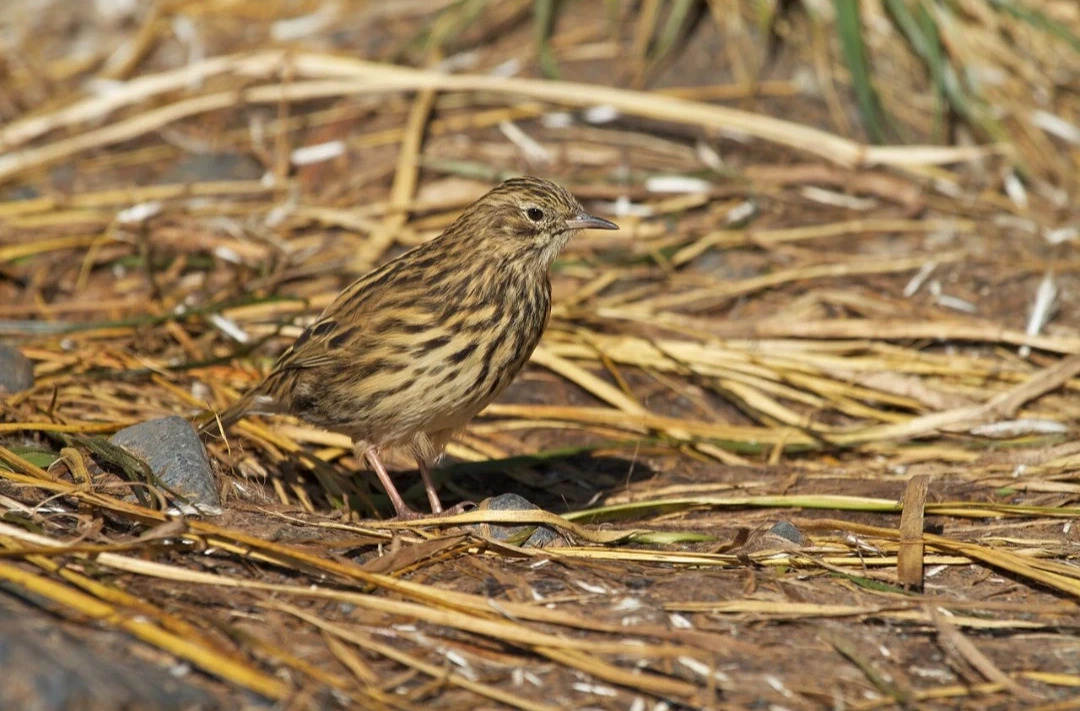Antarctic Shearwaters and Petrels
Shearwaters and petrels are seabirds commonly found throughout Antarctic waters, where they play essential roles in the Southern Ocean ecosystem. Adapted to long-distance flight, these birds travel extensive ranges to forage, gliding effortlessly on the strong winds of the region. Their diets consist mainly of fish, squid, and krill, which they often capture by diving or surface seizing.
Both shearwaters and petrels have breeding colonies on remote Antarctic islands, where they nest in burrows or rock crevices to protect their young from harsh weather and predators. However, these populations face numerous threats, including climate change, which affects the availability of prey, and bycatch from fishing operations.
Conservation efforts are increasingly focused on safeguarding their breeding habitats and reducing human impacts on their feeding grounds.
Petrel Species
Antarctic Petrel (Thalassoica antarctica)
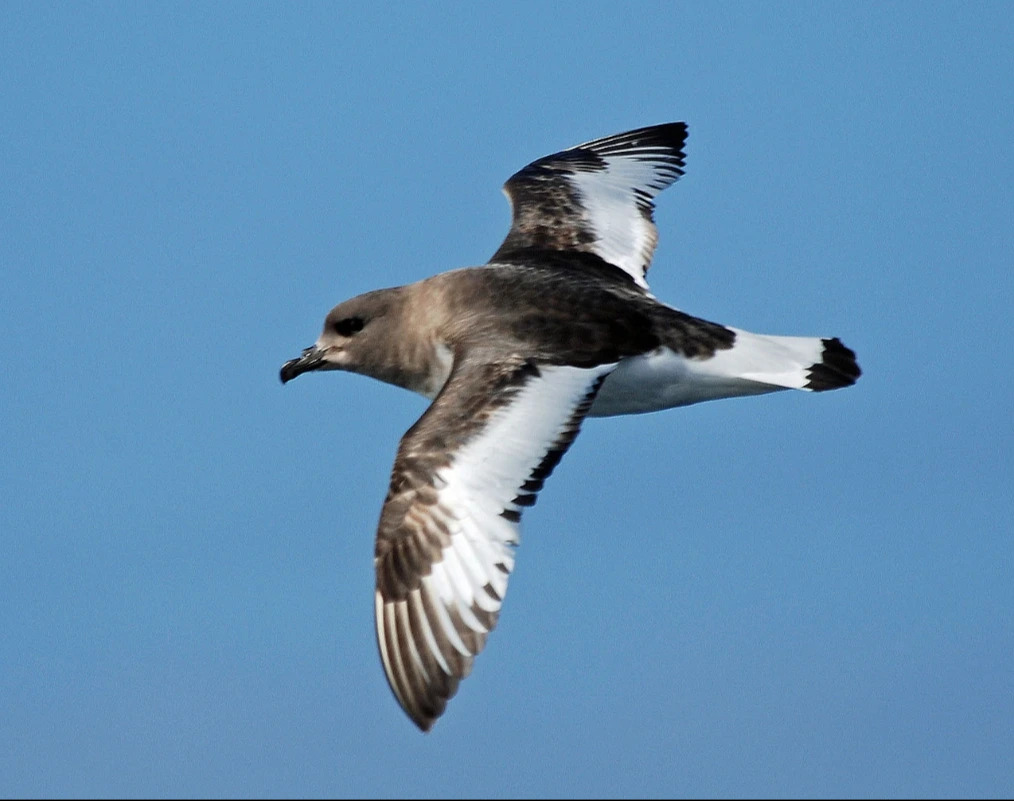
Antarctic petrels (Thalassoica antarctica) are seabirds endemic to the Antarctic region, uniquely adapted to the cold, harsh conditions of the Southern Ocean. They are medium-sized birds with distinct brown and white plumage, often spotted near pack ice or along open waters where they forage for fish, squid, and krill. Antarctic petrels are highly resilient, nesting on rocky cliffs and exposed slopes in large colonies on the Antarctic continent and nearby islands.
These birds are integral to the marine ecosystem, as they contribute to nutrient cycling and act as both predator and prey within their food web. However, their populations are susceptible to climate change, particularly due to alterations in sea ice and food availability, as well as threats from predation on breeding grounds by invasive species.
Conservation measures aim to protect their habitats and manage human impacts on their populations.
Appearance
The Antarctic petrel is distinguished by its contrasting dark brown and white plumage, with a wingspan reaching up to 110 cm (43 inches). Adults display a unique pattern, with dark brown wings and back, a white belly, and a white face that sharply contrasts with their dark eyes. This medium-sized seabird, weighing between 400 to 800 grams (0.88 to 1.76 lbs), is built for endurance and agility in the air.
Behaviour
Antarctic petrels are highly social birds, often seen in large flocks, especially around breeding sites and feeding areas. They are excellent flyers, capable of covering vast distances in search of food, and adept at using the wind currents to glide over the ocean and ice. During the breeding season, their nesting colonies on cliff ledges become bustling communities, with pairs engaging in synchronized flights and calls.
Diet
Their diet mainly consists of krill, small fish, and squid, which they catch by surface seizing or shallow dives. Feeding takes place both close to the breeding sites and in open waters, where they can be observed following ships and utilizing updrafts for efficient flight while foraging.
Reproductive Cycle
Breeding begins in late November to December when Antarctic petrels return to their colonies situated on rocky cliffs and steep slopes. They lay a single egg in a shallow scrape or on bare rock, with both parents sharing incubation duties. The chick is then raised on a diet rich in fish and krill, fledging in about 45 to 50 days, ready to face the challenges of the Antarctic environment.
Habitat and Range
The Antarctic petrel is a true child of the Antarctic, breeding exclusively on the continent and its nearby islands. It is most commonly found in the high Antarctic zone, with breeding colonies scattered across regions like Queen Maud Land. Outside the breeding season, they roam widely over the Southern Ocean, reaching subantarctic waters and occasionally being spotted as far north as Australia and New Zealand.
The Antarctic petrel’s presence in the Southern Ocean is a testament to nature’s adaptability, and showcases their remarkable ability to thrive in extreme conditions. Their life cycle, deeply intertwined with the Antarctic ecosystem, underscores the urgency of monitoring and protecting these regions, offering a poignant reminder of the fragility and wonder of polar ecosystems.
Back To Top
Snow Petrel (Pagodroma nivea)
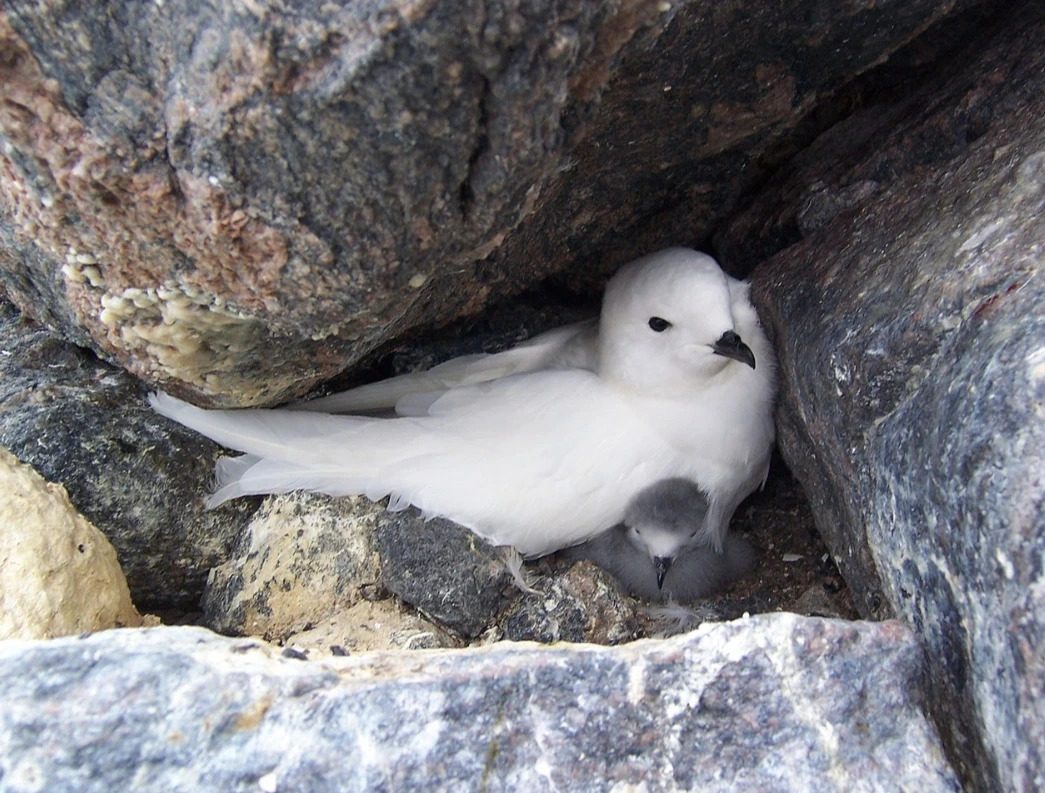
Snow petrels (Pagodroma nivea) are small, pure-white seabirds that inhabit the Antarctic region exclusively, making them one of the southernmost breeding bird species. Adapted to withstand extreme cold, these birds rely on dense plumage to insulate against freezing temperatures.
Typically nesting on exposed cliffs and rocky outcrops near the Antarctic ice sheet, snow petrels select high-altitude sites and sheltered crevices to protect their eggs. Their role in Antarctic ecosystems is significant, though they are increasingly vulnerable to climate change. Shifting ice conditions and changing prey availability threaten their breeding success, prompting conservation efforts focused on preserving their nesting habitats and minimising human impact in the region.
Appearance and Size
The snow petrel is striking in its simplicity, with entirely white plumage that gleams against the Antarctic landscape. It has a relatively small size for a seabird, with a wingspan of up to 80 cm (31 inches) and weighing around 350 to 500 grams (0.77 to 1.1 lbs). The bird is characterized by its black bill, eyes, and feet, which stand out against its snow-white feathers, making it one of the most recognizable species in its habitat.
Behaviour
Snow petrels are highly sociable and agile flyers, capable of navigating through harsh winds and snowstorms with ease. They exhibit strong site fidelity, returning to the same nesting areas year after year. These birds are also known for their loud, cackling calls, which resonate across their nesting colonies on steep cliffs and rocky outcrops.
Diet
Their diet primarily consists of fish, squid, and krill, along with other small sea creatures. Snow petrels are opportunistic feeders, often spotted following fishing vessels for scraps or foraging in open waters. They feed by dipping into the ocean’s surface while in flight or making shallow dives to capture their prey.
Reproductive Cycle
Breeding takes place in isolated sites, with pairs nesting in rock crevices, caves, or on ledges in high cliffs, well away from predators. They lay a single white egg in a bare scrape or shallow depression, which both parents incubate. The chick is fed a rich, oily diet regurgitated by the parents, growing quickly to fledge within about seven weeks.
Habitat and Range
The snow petrel is a true Antarctic species, breeding and feeding within the Antarctic Convergence. It is widely distributed around the continent, from the Peninsula to the deep south, choosing the most inhospitable areas to make its home. Outside the breeding season, snow petrels can range further north, reaching subantarctic islands and the colder waters of the southern oceans.
The snow petrel, with its stark white beauty and remarkable adaptability, stands as a testament to the resilience of life in Antarctica. These birds, navigating the extremes of the polar world, underscore the critical need to understand and protect the unique ecosystems of the Antarctic. Their presence highlights the interconnectedness of global climates, marine life, and the ongoing challenges posed by environmental changes.
Back To Top
Blue Petrel (Halobaena caerulea)
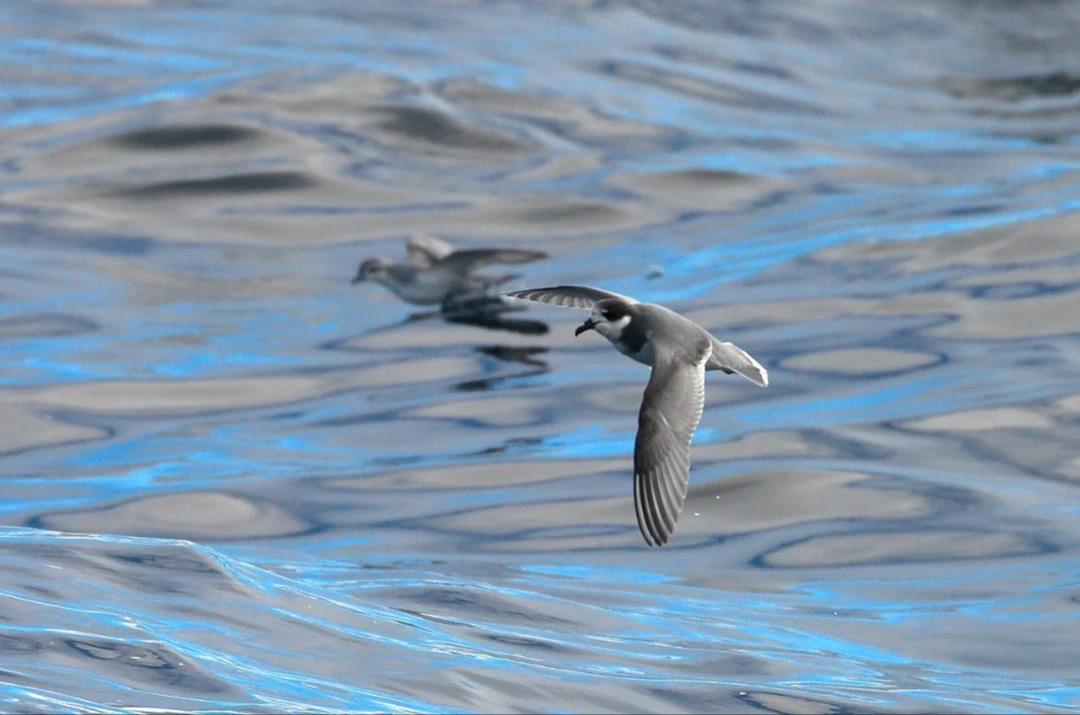
Blue petrels (Halobaena caerulea) are small seabirds native to the Southern Ocean, characterised by their distinctive bluish-grey upper feathers and white underparts. They inhabit sub-Antarctic islands, where they breed in colonies, often nesting in burrows or crevices to protect their eggs and chicks from harsh weather and predators. Blue petrels are strong, long-distance foragers, feeding primarily on small fish, squid, and krill, which they catch through surface seizing or shallow dives.
These birds are critical to the sub-Antarctic ecosystem, contributing to nutrient transfer between land and sea. However, blue petrel populations face threats from climate change, which affects food availability, and from introduced predators such as rats on breeding islands. Conservation measures target habitat protection and invasive species control to support blue petrel population stability.
Appearance and Size
The blue petrel is characterized by its slender body and the striking blue-grey colouration of its upperparts, contrasting with the white underparts. It has a distinctive black mask across its eyes, a small, black bill, and blue-grey feet. Adults typically measure about 30 cm (12 inches) in length, with a wingspan of approximately 65 cm (25.6 inches), and weigh around 200 grams (0.44 lbs), making them one of the smaller petrel species.
Behaviour
Blue petrels are highly pelagic, spending the majority of their lives at sea, except during the breeding season. They are known for their strong, direct flight and their ability to skim the ocean’s surface, utilizing the wind to glide effortlessly. At night, they return to their nesting sites in colonies, where their eerie calls fill the air, facilitating communication between mates and signalling their presence to neighbours.
Diet
Their diet consists predominantly of krill, small fish, and squid, which they catch by surface seizing and shallow diving. Blue petrels are adept at exploiting the abundance of prey in the Southern Ocean, often foraging in large flocks and sometimes associating with other seabird species to locate feeding areas.
Reproductive Cycle
Breeding takes place in burrows or crevices on remote sub-Antarctic islands, where blue petrels lay a single white egg. Both parents share the duties of incubating the egg and feeding the chick, which is nurtured on a diet rich in fish oil and squid. The breeding season is a critical time when adults must balance their energy between foraging at sea and attending to their nest.
Habitat and Range
The blue petrel is found circumpolarly in the Southern Ocean, breeding on various sub-Antarctic islands such as the Kerguelen, Crozet, and South Georgia islands. Their preference for nesting in burrows helps protect their young from the harsh climate and predators, allowing them to thrive in these secluded environments.
The blue petrel’s life amidst the swirling waters and rugged islands of the sub-Antarctic highlights the extraordinary adaptations of seabirds to the marine environment. Their survival and breeding success are closely tied to the health of the Southern Ocean, making them important indicators of ecological change. As such, understanding the life cycle and ecology of the blue petrel is essential for the conservation of these remote and vital marine habitats.
Back To Top
Black-bellied Storm Petrel (Fregetta tropica)
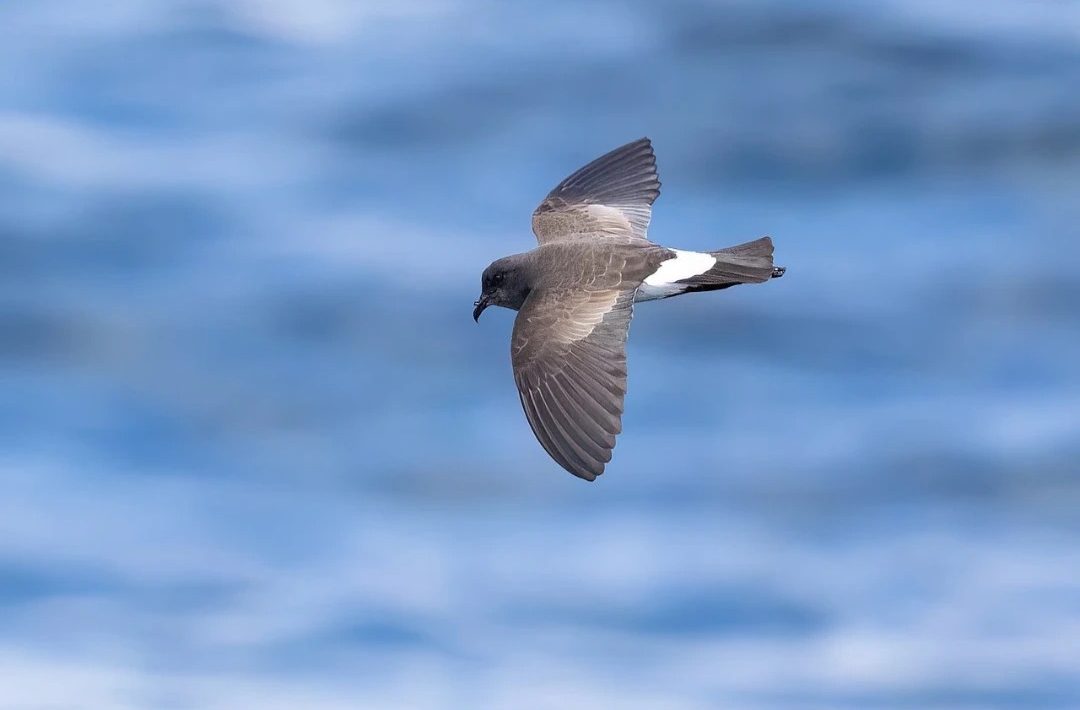
The black-bellied storm petrel (Fregetta tropica) is a small seabird inhabiting the Southern Ocean, easily identifiable by its dark belly and contrasting white underparts with black-edged wings. With a highly agile flight, this petrel spends most of its life at sea, returning to land only for breeding.
During breeding seasons, black-bellied storm petrels nest in crevices, burrows, or sheltered rock areas on sub-Antarctic islands. Although relatively resilient, their populations are at risk from habitat disturbances and predation by invasive species on breeding islands. Conservation initiatives aim to manage these invasive threats and safeguard essential breeding sites for the continued survival of this pelagic species.
Appearance and Size
The black-bellied storm petrel is a small seabird, measuring about 19 to 23 cm (7.5 to 9 inches) in length, with a wingspan of approximately 42 to 46 cm (16.5 to 18 inches), and weighing around 35 to 50 grams (1.2 to 1.7 oz). Its most striking feature is the contrast between its pale grey upperparts and the distinctively dark, almost black belly and underwings, accented by a white rump and a thin white band across the upper wings. The bird’s legs extend past its short tail in flight, contributing to its distinctive silhouette.
Behaviour
Black-bellied storm petrels are highly pelagic, spending most of their lives far from land, except when breeding. They exhibit remarkable flying skills, capable of performing swift, darting movements and hovering just above the water’s surface to feed. At night, these birds are often more active, using the cover of darkness to avoid predators.
Diet
Their diet primarily consists of planktonic crustaceans, small fish, and squid, which they pick from the water’s surface while in flight. Black-bellied storm petrels are adept at locating food in the vast open ocean, often feeding on the wing and capitalizing on upwellings rich in marine life.
Reproductive Cycle
Breeding occurs on remote sub-Antarctic islands, where black-bellied storm petrels nest in colonies, laying their eggs in burrows or crevices among rocks and vegetation. They lay a single egg per breeding season, with both parents sharing incubation duties and chick rearing, feeding their young with regurgitated food until they are ready to fledge.
Habitat and Range
The black-bellied storm petrel has a circumpolar distribution in the Southern Ocean, favouring sub-Antarctic and Antarctic waters. They breed on isolated islands throughout their range, selecting sites that offer protection from the elements and predators, crucial for their survival in these harsh environments.
The black-bellied storm petrel’s existence in the Southern Ocean’s vast and open waters highlights the remarkable adaptations of seabirds to some of the harshest conditions on Earth. Their life cycle, closely tied to the rhythm of the sea, underscores the importance of international efforts to understand and protect the dynamic and biodiverse marine ecosystems of the sub-Antarctic and Antarctic regions.
Back To Top
Wilson’s Storm Petrel (Oceanites oceanicus)
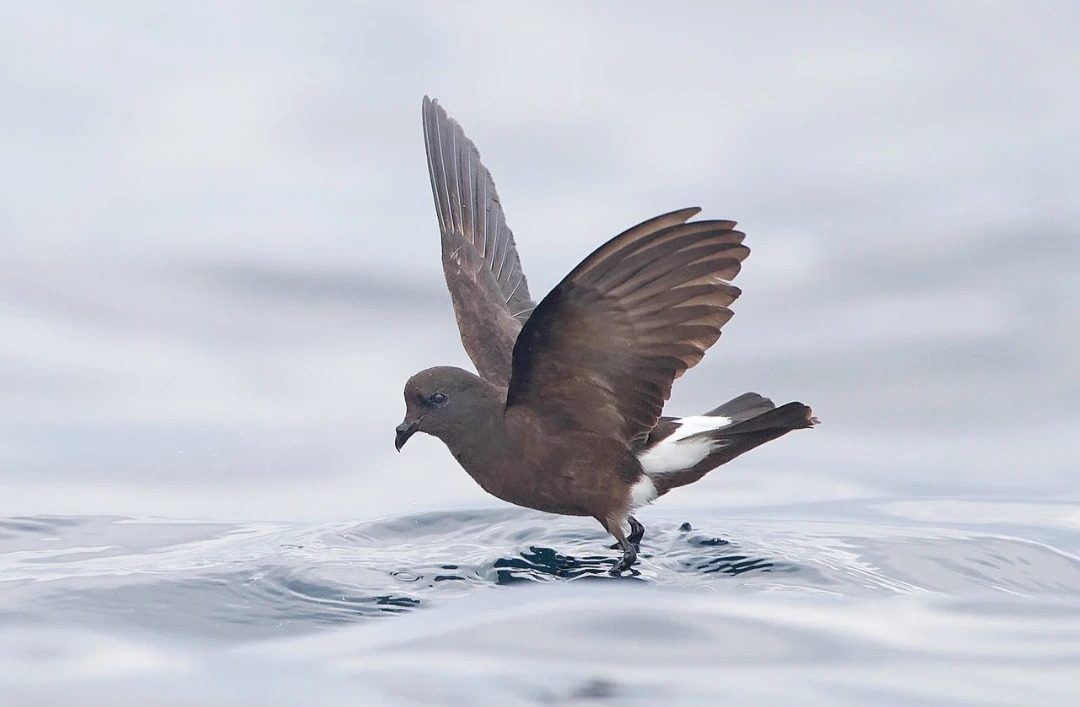
Wilson’s storm petrel (Oceanites oceanicus) is one of the most widespread seabirds, found across all oceans but predominantly in the Southern Ocean during its breeding season. Small and dark brown with a distinctive white rump, Wilson’s storm petrel has a characteristic fluttering flight pattern and is often seen skimming close to the water’s surface in search of plankton, small fish, and crustaceans.
The species breeds on rocky cliffs and scree slopes of sub-Antarctic and Antarctic islands, nesting in small crevices to shield from predators and extreme weather. Despite being one of the most abundant seabirds, Wilson’s storm petrel faces pressures from climate change and habitat disturbance. Conservation measures are aimed at safeguarding breeding sites and maintaining ecological balance in its marine foraging grounds.
Appearance and Size
Wilson’s storm petrels are one of the smallest seabirds, measuring about 16 to 18 cm (6.3 to 7.1 inches) in length, with a wingspan of 38 to 42 cm (15 to 16.5 inches), and weighing between 20 to 35 grams (0.7 to 1.2 oz). They are characterized by their dark brown to black plumage, contrasted by a distinctive white rump and a broad, semi-circular white band on the underwing. Their legs are long, extending beyond the tail in flight, with webbed feet that they use to “walk” on the water’s surface as they feed.
Behaviour
Wilson’s storm petrels are known for their buoyant and erratic flight pattern, often described as dancing over the ocean’s surface. They are highly pelagic, spending most of their life at sea, except during the breeding season. These birds exhibit a strong affinity for stormy weather, skillfully manoeuvring through the winds and waves to forage for food.
Diet
Their diet consists mainly of planktonic crustaceans, small fish, and squid, which they capture by picking off the water’s surface while hovering in flight. Wilson’s storm petrels are opportunistic feeders, often following ships and feeding at night to take advantage of sea surface bioluminescence, which attracts their prey.
Reproductive Cycle
Breeding takes place in Antarctic and sub-Antarctic islands, where they nest in rock crevices, burrows, or under stones in large colonies. They lay a single white egg each season, which is incubated by both parents. The chicks are fed with a rich, oily substance produced by the adults, growing rapidly until they fledge.
Habitat and Range
Wilson’s storm petrels have an extensive range, breeding on the Antarctic continent and surrounding islands during the Southern Hemisphere’s summer. After breeding, they undertake an impressive migration to spend the Northern Hemisphere’s summer in the North Atlantic, making them one of the most widely traveled of all bird species.
The Wilson’s storm petrel’s enduring presence in the Southern Ocean speaks to the marvel of evolutionary adaptation, allowing them to thrive in one of the most extreme environments on Earth. Their widespread distribution and migratory patterns underscore the global nature of marine ecological systems, emphasizing the importance of international cooperation in the conservation of migratory seabirds and their habitats.
Back To Top
Giant Petrel (Macronectes giganteus)
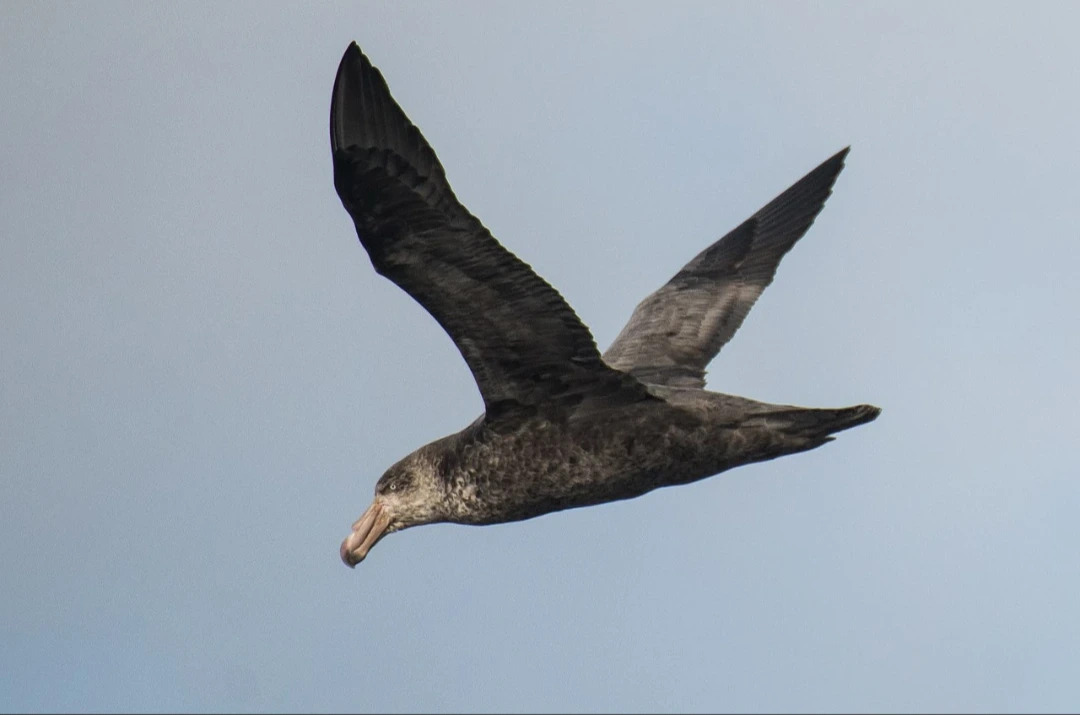
Giant petrels (Macronectes Giganteus), found in the Southern Ocean and sub-Antarctic regions, are the largest petrels and notable scavengers of the seabird community.
With strong, hooked bills and robust bodies, they can be aggressive foragers, often feeding on carrion, including seal and penguin carcasses, as well as preying on fish, squid, and other seabirds. There are two species—the northern and southern giant petrels—both of which play crucial roles in the Antarctic ecosystem as apex scavengers.
Giant petrels breed on isolated islands, where they nest on open ground, often in exposed areas. While adaptable, they are vulnerable to threats like climate change, fisheries bycatch, and habitat disturbance. Conservation efforts focus on monitoring populations, protecting breeding sites, and implementing bycatch reduction measures in fisheries.
Appearance and Size
Giant petrels come in two species, the Northern (Macronectes halli) and Southern (Macronectes giganteus) giant petrel, both characterized by their large bodies and long wingspans, reaching up to 2 meters (6.6 feet). They weigh between 3 to 8 kg (6.6 to 17.6 lbs), with males generally larger than females. Their plumage ranges from mottled brown to almost completely white, and they have a distinctively large bill with a greenish-yellow tip, enabling them to tear into their prey or carrion.
Behaviour
Known for their powerful flight, giant petrels can travel thousands of kilometers in search of food. They are highly opportunistic, feeding both at sea and on land, and are not shy about asserting dominance over carcasses, often chasing away other scavengers. Despite their aggressive feeding behavior, they show remarkable tenderness during courtship and when caring for their young.
Diet
Their diet is incredibly varied, including fish, squid, krill, and other marine invertebrates, as well as scavenging on the carcasses of seals, penguins, and whales. Giant petrels are essential to the Antarctic ecosystem, helping to recycle nutrients and keep beaches clean.
Reproductive Cycle
Giant petrels breed on isolated, sub-Antarctic islands, often on bare ground or among tussock grass. They lay a single egg, which both parents incubate in shifts. The chick is then cared for by both parents, who feed it regurgitated food until it is ready to fledge and face the challenges of the ocean.
Habitat and Range
While both species of giant petrel range widely across the Southern Ocean and into some temperate regions, the Southern giant petrel is more closely associated with the Antarctic continent. They are adapted to life in extremely remote and harsh conditions, from the high seas to the uninhabited islands where they breed.
The giant petrel’s presence in the Southern Ocean is a symbol of the wild and pristine nature of the Antarctic and sub-Antarctic ecosystems. Their survival and thriving in such extreme conditions underline the critical need for concerted conservation efforts to protect these birds and their habitats from the growing threats of climate change and human activity.
Understanding the life and habits of the giant petrel sheds light on the broader ecological dynamics of the Southern Ocean, emphasizing the interconnectedness of all life in this remote part of the world.
Back To Top
South Georgia Diving Petrel (Pelecanoides georgicus)
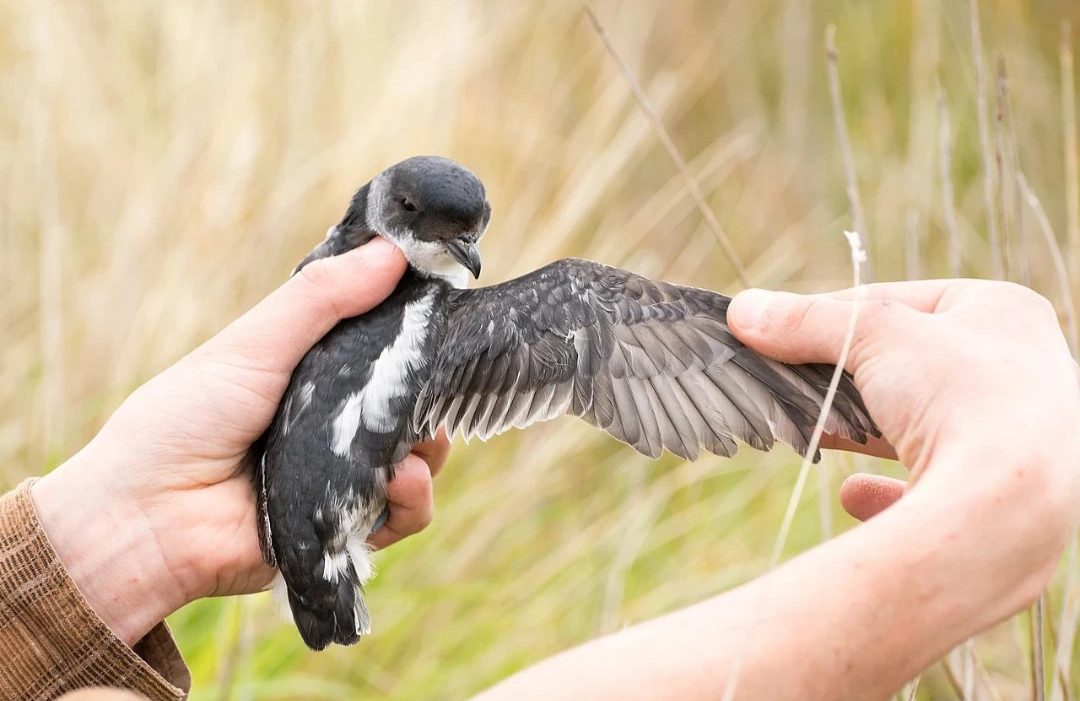
The South Georgia diving petrel (Pelecanoides georgicus) is a small seabird native to the sub-Antarctic and found primarily around South Georgia and nearby islands. Unlike other petrels, it is a specialised diver, using its short wings and strong legs to pursue small fish, crustaceans, and plankton underwater. This petrel nests in burrows on sandy slopes and grassy areas near coastal regions, where it forms small colonies.
The species faces threats from habitat loss due to invasive species such as rats and mice, which prey on eggs and chicks. Conservation efforts for the South Georgia diving petrel focus on invasive species eradication, habitat protection, and careful monitoring to aid in population recovery and stabilisation.
Appearance and Size
The South Georgia diving petrel is a small, robust bird, measuring about 18 to 21 cm (7 to 8.3 inches) in length, with a wingspan of approximately 38 to 41 cm (15 to 16.1 inches), and weighing between 120 to 200 grams (4.2 to 7.1 oz). Characterized by its slate-grey plumage on the back and a contrasting white belly, it possesses a short, stout bill perfectly adapted for its diet of small fish and crustaceans.
Behaviour
These petrels exhibit remarkable diving skills, propelling themselves underwater with their wings to hunt for prey. They are equally adept at maneuvering through the air, using the wind currents above the ocean’s surface to glide effortlessly. On land, they are more cumbersome, nesting in burrows to protect their offspring from the harsh Antarctic elements and predators.
Diet
South Georgia diving petrels feed on a variety of small fish, squid, and krill, diving to depths to capture their meals. Their foraging techniques highlight their adaptation to the marine environment, capable of exploiting the rich, cold waters of the Southern Ocean for sustenance.
Reproductive Cycle
The breeding season sees these petrels returning to sub-Antarctic islands to lay their eggs in carefully constructed burrows. A single egg is laid per breeding cycle, with both parents sharing incubation duties and chick rearing, ensuring their young are well-fed and prepared for life at sea.
Habitat and Range
Primarily associated with the sub-Antarctic island of South Georgia, the South Georgia diving petrel’s habitat extends to other nearby islands within the Southern Ocean. This range is characterized by cold, nutrient-rich waters, vital for supporting the dense marine life that constitutes their diet.
The preservation of the South Georgia diving petrel and its environment is crucial for the continued health and vitality of sub-Antarctic ecosystems. Their life and breeding habits, closely linked to the Southern Ocean’s ecological balance, underscore the urgency of addressing climate change and mitigating human impacts on these remote, yet vitally important, marine habitats. Understanding and protecting the South Georgia diving petrel is essential not only for the species’ survival but also for maintaining the biodiversity and ecological integrity of the Southern Ocean.
Back To Top
Common Diving Petrel (Pelecanoides urinatrix)
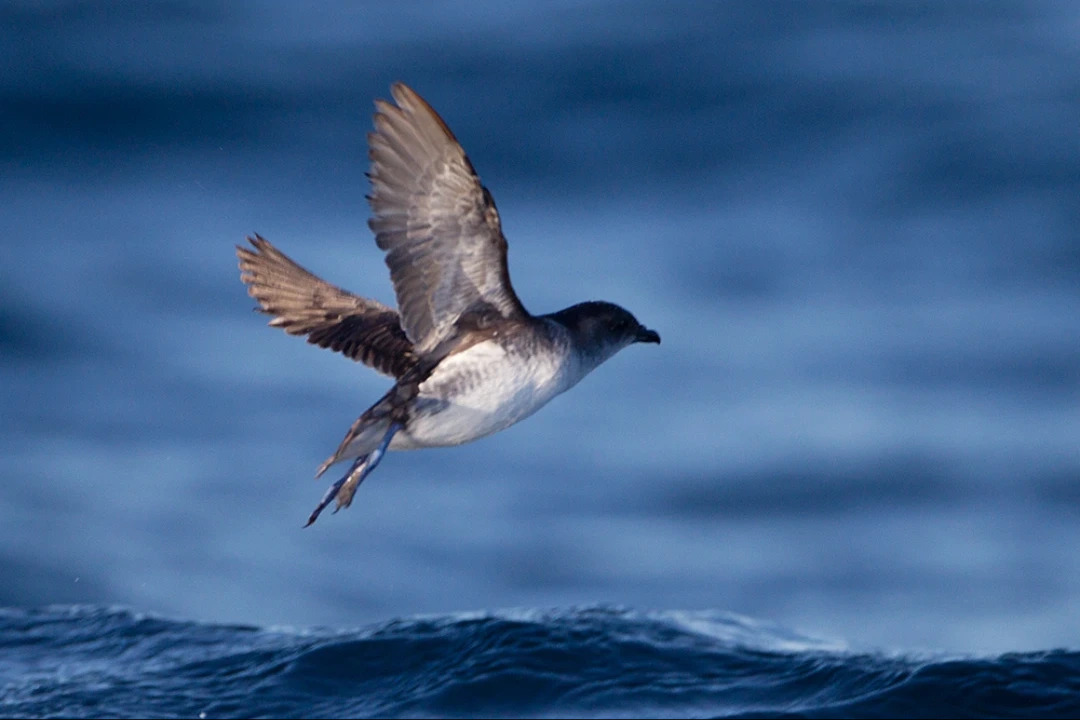
The common diving petrel (Pelecanoides urinatrix) is a small seabird widespread in the Southern Ocean, found on sub-Antarctic and temperate islands. Adapted for underwater foraging, it uses rapid wingbeats to “fly” through water, diving to catch small fish, crustaceans, and plankton. This petrel nests in burrows, often on slopes with loose soil or in grasslands close to the coast, forming small to medium-sized breeding colonies.
Despite its resilience, the common diving petrel faces pressures from habitat loss and invasive species like rats and cats, which threaten eggs and chicks. Conservation strategies focus on invasive species control and habitat preservation, particularly on breeding islands, to support stable populations.
Appearance and Size
The common diving petrel is notably compact and sturdy, measuring approximately 19 to 23 cm (7.5 to 9 inches) in length, with a wingspan around 38 to 41 cm (15 to 16 inches), and weighing between 120 to 200 grams (4.2 to 7.1 oz). They are characterized by their dark plumage, which is uniformly sooty-grey across the body, contrasting with a lighter throat. Their short, strong bill and webbed feet are well-adapted for a life spent mostly at sea.
Behaviour
These petrels are exceptional divers, using their wings to propel themselves underwater in pursuit of prey, able to reach considerable depths relative to their size. In flight, they exhibit swift, direct movements close to the water’s surface. Common diving petrels are also known for their burrow-nesting habits, with colonies often located in tussock grasslands or soft soil near the shore.
Diet
Predominantly feeding on small fish, squid, and a significant amount of crustaceans, common diving petrels forage at sea, diving from the surface to catch their prey. Their feeding habits showcase their ability to exploit the rich marine resources of their habitats efficiently.
Reproductive Cycle
The breeding season sees these petrels returning to sub-Antarctic islands to lay their eggs in carefully constructed burrows. A single egg is laid per breeding cycle, with both parents sharing incubation duties and chick rearing, ensuring their young are well-fed and prepared for life at sea.
Habitat and Range
The common diving petrel inhabits a wide range of the Southern Hemisphere’s oceans, from sub-Antarctic regions to temperate coastal areas. Their distribution reflects their versatility in adapting to different marine environments, relying on the availability of suitable nesting sites and abundant food sources.
The conservation of common diving petrels highlights the broader challenges of marine biodiversity preservation, particularly in regions impacted by climate change and human activity. By understanding the life and habits of the common diving petrel, we gain insights into the resilience of seabirds and the critical importance of protecting the marine ecosystems that sustain them.
Back To Top
White-chinned Petrel (Procellaria aequinoctialis)
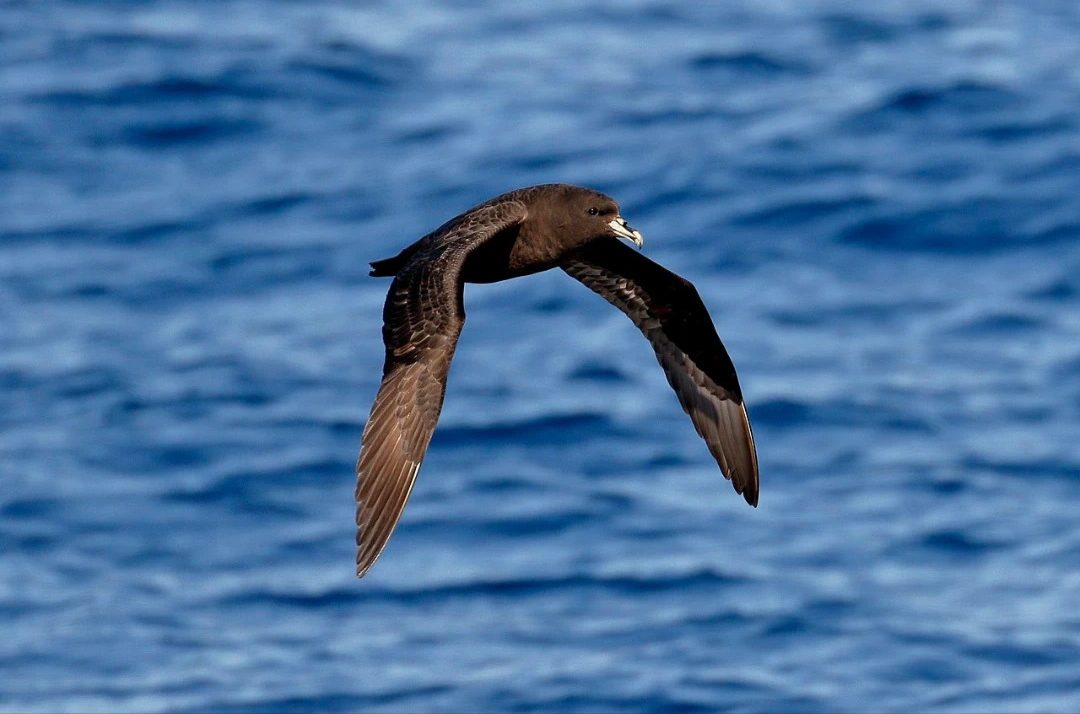
The white-chinned petrel, with its impressive size and striking appearance, navigates the vast and stormy Southern Ocean, symbolizing the wild and untamed spirit of the high seas. Known for the distinctive white patch beneath its bill, from which it gets its name, this seabird is an integral part of the marine ecosystem, showcasing the remarkable adaptability and resilience required to thrive in some of the world’s most challenging marine environments.
The white-chinned petrel’s lifecycle, characterized by long-distance foraging flights and nesting in remote island burrows, offers insight into the complex behaviours and survival strategies of pelagic seabirds. As a key indicator of ocean health, the white-chinned petrel’s feeding habits and population trends provide valuable data on the impacts of climate change, bycatch, and pollution on marine biodiversity.
The conservation of this species and its habitat is crucial, highlighting the need for international collaboration to ensure the future of the Southern Ocean’s rich and diverse ecosystem.
Appearance and Size
The white-chinned petrel is one of the larger petrel species, measuring about 50 to 58 cm (20 to 23 inches) in length, with a wingspan of 134 to 147 cm (53 to 58 inches), and weighing between 1 to 1.5 kg (2.2 to 3.3 lbs). Its plumage is predominantly sooty black, with the notable exception of a white patch under its chin, which can vary in size. This bird is equipped with a robust, black bill and strong webbed feet, making it well-adapted to its pelagic lifestyle.
Behaviour
These petrels are known for their powerful and graceful flight, capable of covering great distances over open water. They exhibit strong social behavior, especially when foraging, often gathering in large numbers at food sources. White-chinned petrels are also vocal at their breeding sites, using a variety of calls to communicate with mates and rivals.
Diet
The diet of the white-chinned petrel consists mainly of fish, squid, and krill, which they catch by surface seizing or performing shallow dives. They are opportunistic feeders, sometimes following fishing vessels to scavenge offal, making them susceptible to becoming bycatch in fishing gear.
Reproductive Cycle
Breeding takes place in burrows or under vegetation on sub-Antarctic islands. The white-chinned petrel lays a single egg per breeding season, which is incubated by both parents. Chick rearing is a cooperative effort, with both parents foraging at sea to feed their growing chick until it fledges.
Habitat and Range
This species has a circumpolar distribution in the Southern Ocean, but are mostly found in South Georgia. Outside the breeding season, white-chinned petrels disperse widely across the Southern Hemisphere’s oceans, from South America’s coasts to Australia and New Zealand, showcasing their adaptability to different marine environments.
The preservation of the white-chinned petrel underscores the broader challenge of safeguarding marine biodiversity in the face of increasing environmental threats. By understanding and protecting the white-chinned petrel, we contribute to the health and resilience of the Southern Ocean’s ecosystem, ensuring that it continues to support a diverse array of life for generations to come.
Back To Top
Shearwater Species
Great Shearwater (Ardenna gravis)
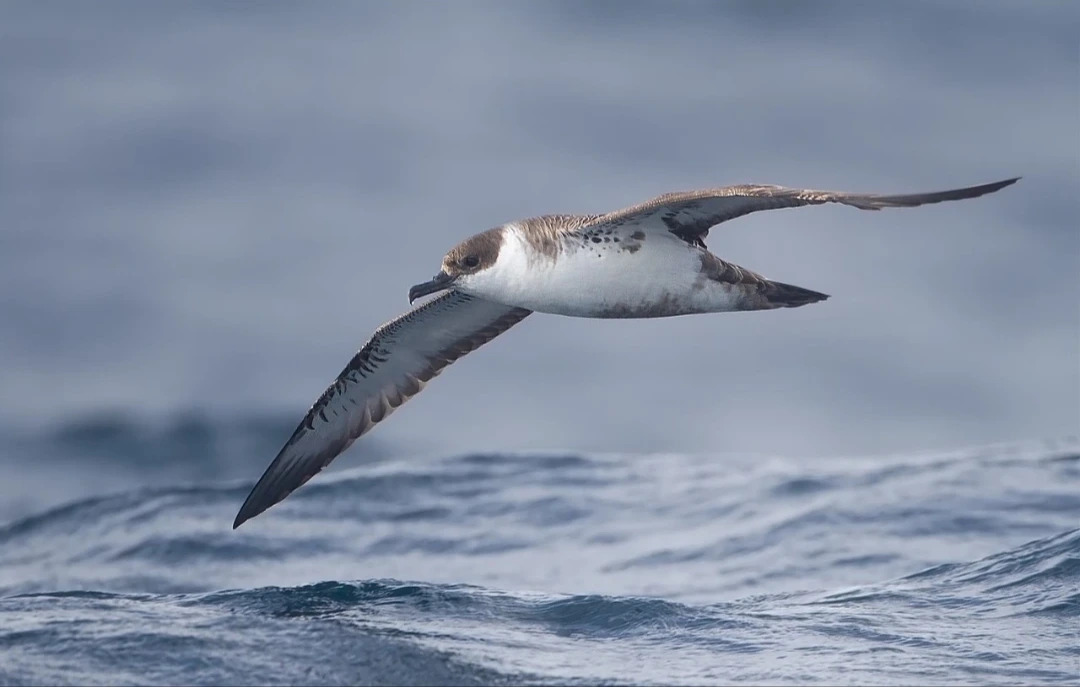
The great shearwater is a master navigator of the open seas, embarking on remarkable trans-equatorial migrations that span vast distances between the Northern and Southern Hemispheres. This bird, with its distinctive dark cap and white underparts, is a symbol of the interconnectedness of the world’s oceans, demonstrating the incredible endurance and adaptability required for life at sea.
The great shearwater’s journey from its breeding grounds on remote South Atlantic islands to the nutrient-rich waters of the North Atlantic is a testament to its remarkable navigational skills and the seasonal rhythms that dictate the lives of seabirds. As an avid forager, the great shearwater plays a vital role in the marine food web, helping to maintain the balance of oceanic ecosystems.
Studying this species offers insights into migratory patterns, the impacts of ocean health on seabird populations, and the effects of climate change on migratory routes. The conservation of the great shearwater and its habitats is crucial for understanding the dynamics of global marine ecosystems and ensuring the sustainability of these critical natural resources.
Appearance and Size
Great shearwaters are medium-sized seabirds, measuring about 45 to 55 cm (18 to 22 inches) in length, with a wingspan of approximately 100 to 120 cm (39 to 47 inches), and weighing around 700 to 1000 grams (1.5 to 2.2 lbs). Their plumage is characterized by a distinctive pattern: dark brown on the upper parts with a dark cap, a white underbelly, and a conspicuous dark band across the breast. They have long, slender wings adapted for dynamic soaring over the ocean and a robust bill suited for their diet.
Behaviour
These shearwaters exhibit highly gregarious behaviour, often seen in large flocks that can number in the thousands, especially in feeding areas. They are known for their strong, direct flight, utilizing air currents above the waves to cover long distances with minimal effort. Great shearwaters are also vocal at sea, using a variety of calls to communicate with one another.
Diet
Their diet primarily consists of fish, squid, and crustaceans, which they capture by surface seizing, plunge diving, and following fishing vessels for offal. The great shearwater’s foraging strategy reflects its opportunistic feeding habits, enabling it to exploit different food sources over its extensive migratory range.
Reproductive Cycle
Breeding occurs on isolated islands in the South Atlantic, such as the Tristan da Cunha group and Gough Island. Great shearwaters nest in burrows or under tussock grass, laying a single white egg. Both parents share incubation duties and take turns feeding the chick by regurgitation until it is ready to fledge and begin its first migration.
Habitat and Range
The great shearwater is a pelagic species, spending much of its life at sea. It breeds in the South Atlantic but undertakes a long migration to the North Atlantic, where it spends the boreal summer. It’s possible to see them in South Georgia and the Falkland Islands, but only very late in the season.
The conservation of the great shearwater is vital for the health of marine ecosystems across the Atlantic. By protecting this species and its migratory pathways, we contribute to the preservation of the ocean’s biodiversity, ensuring that the great shearwater continues its epic journey across the seas for generations to come.
Back To Top
Sooty Shearwater (Ardenna grisea)
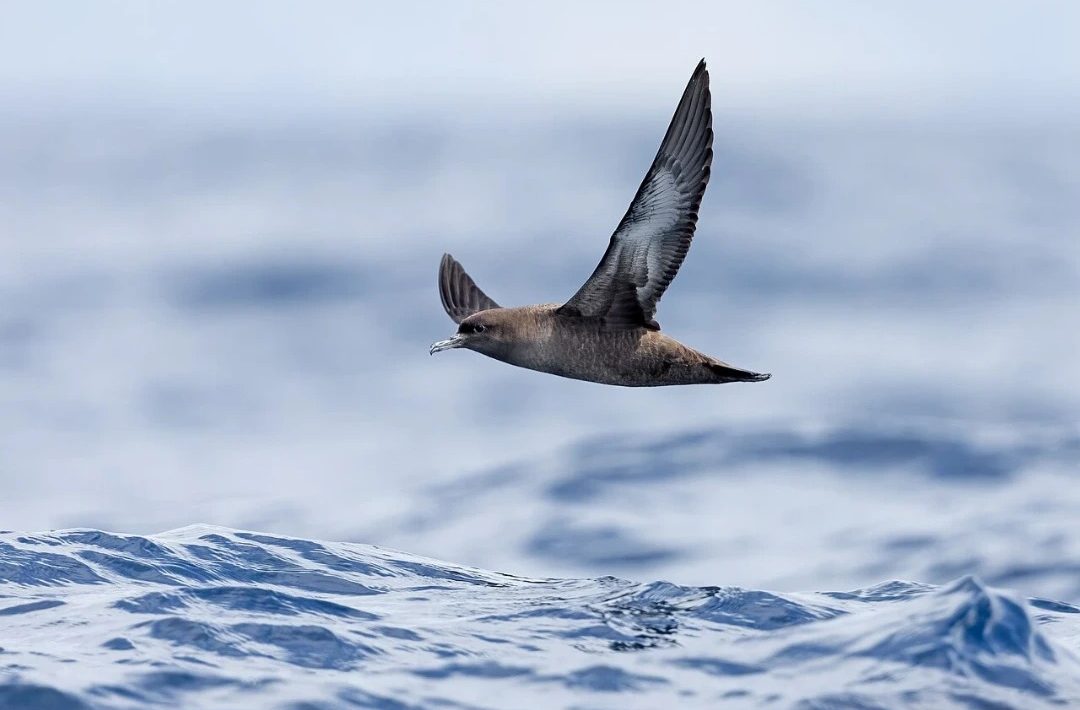
The sooty shearwater, a medium-sized seabird with a dusky silhouette, is an emblem of the world’s oceans’ vastness and mystery. Renowned for its epic migratory journeys, the sooty shearwater traverses thousands of miles across open seas, from its breeding grounds in the Southern Hemisphere to the nutrient-rich waters of the North Atlantic and Pacific.
This bird’s life cycle, characterized by remarkable endurance and navigational precision, sheds light on the intricate patterns that govern nature’s rhythms. As proficient foragers, sooty shearwaters play a crucial role in the marine food web, their diet reflecting the abundance of the seas they travel. Their migrations, driven by the seasons, offer insights into the effects of climate change on pelagic species, highlighting the interconnectedness of global ecosystems.
Studying the sooty shearwater underscores the importance of marine conservation efforts, aiming to preserve the dynamic environments that sustain these extraordinary voyagers of the air and sea.
Appearance and Size
Sooty shearwaters are sleek, with uniformly dark brown or sooty plumage that camouflages them against the open ocean waters. They measure about 40 to 51 cm (16 to 20 inches) in length, with a wingspan of 94 to 110 cm (37 to 43 inches), and weigh between 700 to 1000 grams (1.5 to 2.2 lbs). Their long, narrow wings are adapted for dynamic soaring and hours of flight over vast distances.
Behaviour
These birds are known for their social nature, often seen in large flocks that glide gracefully over the sea, skimming the waves with their wings. Sooty shearwaters are also highly vocal at their breeding sites, using a range of calls to communicate. Their ability to cover great distances is complemented by their proficiency in diving, reaching depths of over 60 meters (200 feet) in pursuit of prey.
Diet
The diet of the sooty shearwater primarily consists of fish, squid, and crustaceans. They employ various feeding techniques, including surface seizing and diving, often foraging at night when many fish species come closer to the surface. Their wide-ranging diet is indicative of their adaptability and the diverse marine habitats they inhabit throughout the year.
Reproductive Cycle
Breeding takes place in colonies on islands in the Southern Hemisphere, where sooty shearwaters nest in burrows excavated in soft soil. They lay a single egg, which both parents incubate. The chick is fed a diet rich in oils and fats, enabling rapid growth and development before fledging and taking to the sea.
Habitat and Range
Sooty shearwaters have one of the most extensive ranges of any seabird species, breeding in the Southern Hemisphere’s sub-Antarctic and temperate regions, including New Zealand, the Falkland Islands, and parts of Chile and Argentina. After breeding, they migrate thousands of miles to feed in the North Atlantic and Pacific Oceans, demonstrating their extraordinary navigational skills and the global nature of their life cycle.
The conservation of the sooty shearwater is essential for understanding the complexities of marine ecosystems and the broader impacts of environmental change on migratory seabirds. Protecting these birds and their habitats across their migratory routes is crucial for maintaining the health of the world’s oceans and the biodiversity they support.
Back To Top
Southern Fulmar (Fulmarus glacialoides)
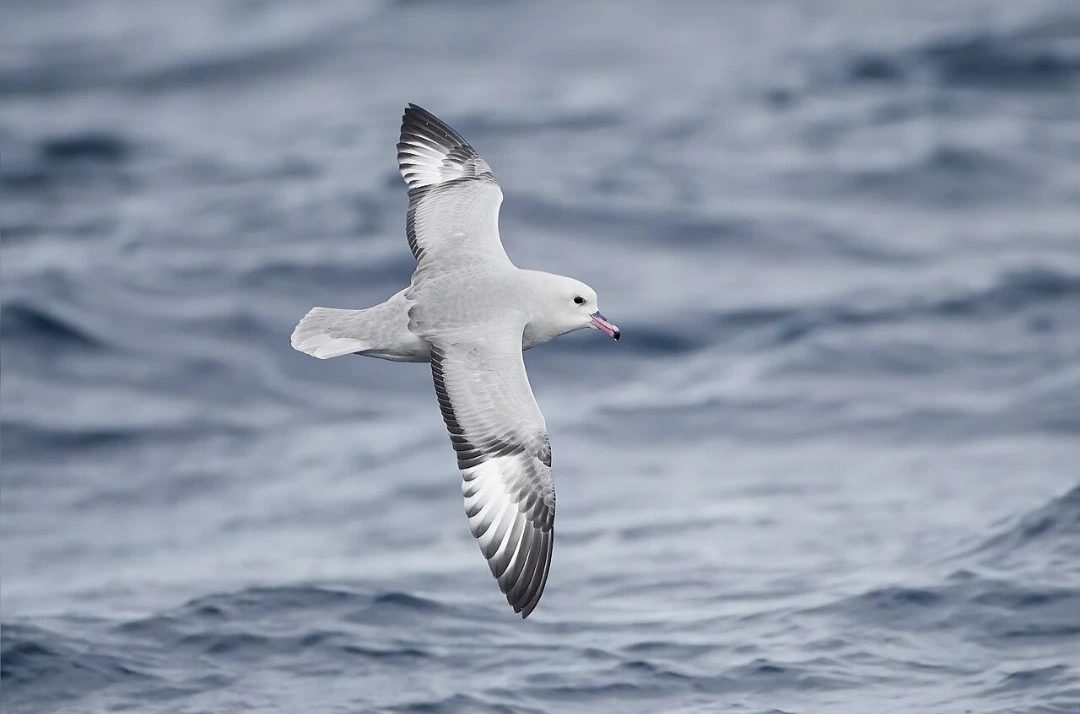
The southern fulmar, also known as the Antarctic fulmar or silver-grey fulmar, graces the cold, windswept skies of the Southern Ocean with its elegant flight and striking plumage. This seabird, with its resilient nature and adaptability, thrives in the Antarctic’s extreme conditions, embodying the harsh beauty and ecological richness of the polar regions.
The southern fulmar’s lifecycle, from its expert gliding over icy waters in search of food to its communal nesting on sheer cliff faces, provides a fascinating glimpse into the survival strategies of birds in one of the world’s most inhospitable environments. As a vital part of the Antarctic food web, the southern fulmar plays a crucial role in marine biodiversity, its feeding habits helping to regulate populations of krill and small fish.
The study of this species offers key insights into the health of the Southern Ocean ecosystem and underscores the importance of ongoing conservation efforts to protect the delicate balance of life in these remote and vulnerable habitats.
Appearance and Size
The southern fulmar is a medium-sized seabird, measuring approximately 45 to 50 cm (18 to 20 inches) in length, with a wingspan of about 115 to 120 cm (45 to 47 inches), and weighing around 700 to 800 grams (1.5 to 1.75 lbs). It features a predominantly light grey plumage with a paler underside and a distinctive darker smudge on the underwing. The bird’s bill is yellow, tipped with a pinkish hue, contrasting with its dark, soulful eyes.
Behaviour
Known for its powerful and sustained flight, the southern fulmar can navigate the turbulent air currents of the Southern Ocean with ease, often accompanying ships for miles. They are highly gregarious during the breeding season, forming large colonies on rocky ledges where their uniform appearance creates a striking scene against the stark Antarctic landscape.
Diet
Southern fulmars feed on a diet rich in krill, small fish, and squid, which they catch by surface seizing or shallow diving. Their feeding strategy often involves following fishing vessels to scavenge offal, showcasing their opportunistic feeding behaviour and adaptability to varying food availability.
Reproductive Cycle
Breeding occurs in colonies located on high cliffs and rocky outcrops, where southern fulmars lay a single white egg in a shallow nest scrape. Both parents share the responsibility of incubating the egg and feeding the chick, demonstrating a strong bond and cooperative parenting that ensures the survival of their offspring in the harsh Antarctic environment.
Habitat and Range
The southern fulmar is widespread across the Southern Ocean, breeding on the Antarctic continent and several sub-Antarctic islands. This bird’s habitat is characterized by cold, ice-covered waters and rugged, inaccessible nesting sites, which offer protection from predators and the elements.
The conservation of the southern fulmar is vital for preserving the Antarctic’s unique wildlife and pristine environments. By protecting this species and its natural habitat, we safeguard the intricate web of life that depends on the Southern Ocean, highlighting the need for global efforts to combat climate change and protect the planet’s last wilderness areas. Understanding the life and challenges of the southern fulmar contributes to our knowledge of polar ecosystems and the importance of marine conservation.
Back To Top
Antarctic Prion (Pachyptila desolata)
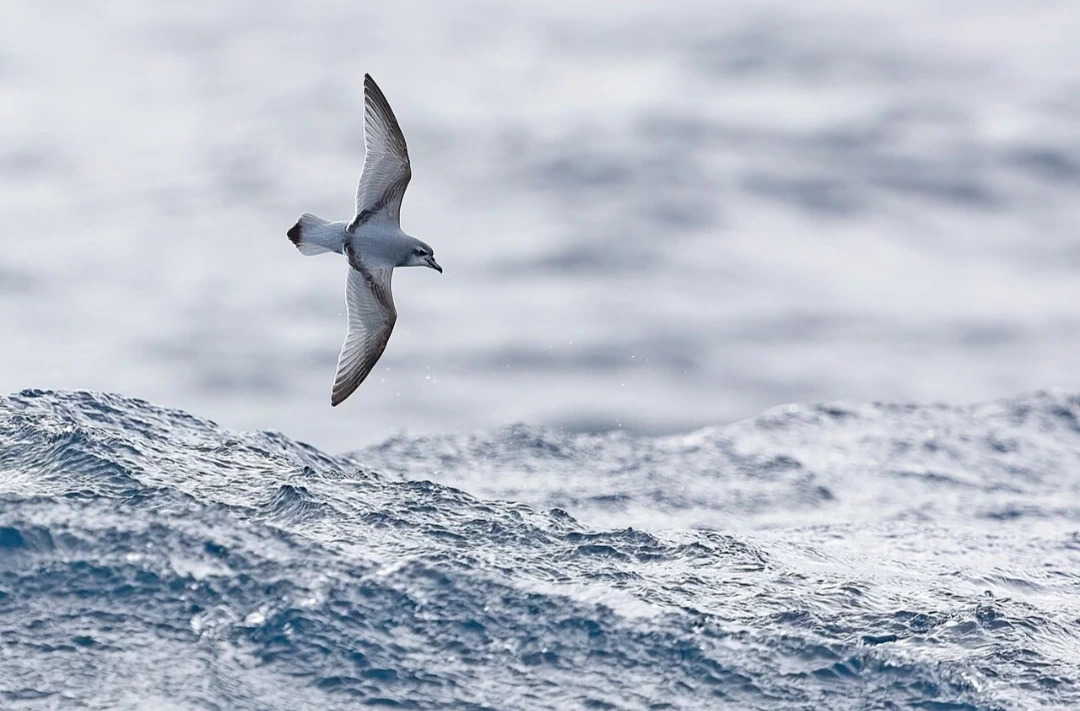
The Antarctic prion, a small seabird with delicate blue-grey plumage and a distinctive bill structure designed for filtering food, embodies the essence of the vast Southern Ocean’s avian life. Inhabiting the cold, nutrient-rich waters that surround Antarctica, this species is adept at navigating the harsh marine environment, showcasing remarkable adaptations for survival.
The Antarctic prion’s life, characterized by its specialized feeding technique, long-distance foraging flights, and communal nesting on remote islands, offers insight into the complex ecological web of the polar regions. As a crucial component of the Antarctic ecosystem, the prion plays a significant role in the marine food web, primarily feeding on small crustaceans.
The study of the Antarctic prion enhances our understanding of seabird ecology in extreme environments and underscores the importance of protecting these birds and their habitat from the impacts of climate change and human activities. Preserving the Antarctic prion and its ecosystem is essential for maintaining the biodiversity and ecological integrity of the Southern Ocean.
Appearance and Size
The Antarctic prion is a petite seabird, measuring about 25 to 28 cm (10 to 11 inches) in length, with a wingspan of approximately 58 to 66 cm (23 to 26 inches), and weighing around 200 grams (7 oz). Its plumage is primarily blue-grey, with a distinctive white underbelly and a striking “M” pattern across its back and wings when in flight. The prion’s bill is unique, equipped with comb-like fringes that allow it to filter planktonic food from the water.
Behaviour
Antarctic prions are highly social birds, often seen in large flocks at sea, especially near their breeding colonies. They exhibit strong flying abilities, capable of gliding over the ocean’s surface for extended periods. These birds are also known for their synchronized flying patterns and vocalizations, which play a crucial role in social interactions and mating.
Predation
Their diet consists mainly of krill, small fish, and other planktonic organisms, which they obtain by surface filtering and hydroplaning, a technique where the bird dips its bill into the water while in flight. This specialized feeding method underscores the Antarctic prion’s adaptation to its marine environment.
Reproductive Cycle
Breeding takes place in large colonies on sub-Antarctic islands, where Antarctic prions nest in burrows or under vegetation to protect their eggs and chicks from predators. They lay a single egg per breeding season, with both parents sharing the duties of incubation and chick rearing, ensuring their young are well-fed and prepared for life at sea.
Habitat and Range
The Antarctic prion breeds on various sub-Antarctic islands and is widespread across the Southern Ocean. Outside the breeding season, it disperses over open waters, showcasing its pelagic nature. The prion’s habitat selection is influenced by the availability of nesting sites and the abundance of food, reflecting the bird’s reliance on the Southern Ocean’s productivity.
The conservation of the Antarctic prion is crucial for preserving the natural heritage of the Southern Ocean.
Back To Top
Slender-billed Prion (Pachyptila belcheri)
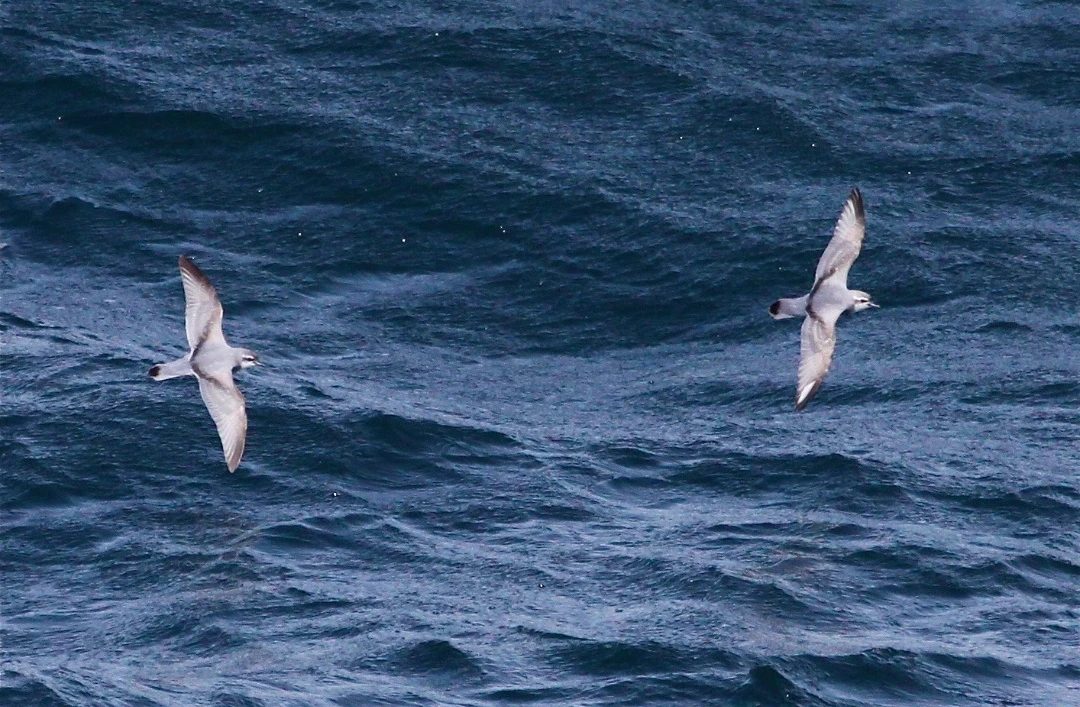
The Slender-billed prion, with its streamlined body and subtle blue-grey plumage, is a testament to the elegance and efficiency of seabirds adapted to life over the open waters of the Southern Ocean. Distinguished by its uniquely adapted bill, which allows for meticulous filtering of small crustaceans from the sea, this species epitomizes the intricate relationship between avian life and the marine environment.
The Slender-billed prion’s existence, from its communal nesting practices on secluded islands to its capacity for extensive foraging voyages, underscores the resilience and adaptability necessary for surviving in some of the world’s most remote and challenging habitats. As a vital part of the Antarctic and sub-Antarctic ecosystems, these birds contribute significantly to the oceanic food web, emphasizing the importance of maintaining healthy, functioning marine ecosystems.
The study and conservation of the Slender-billed prion not only enhance our appreciation for the diversity of life in polar regions but also serve as a crucial indicator for monitoring the impacts of environmental change on these fragile oceanic systems.
Appearance and Size
The Slender-billed prion is a small seabird, typically measuring about 25 to 28 cm (10 to 11 inches) in length, with a wingspan of approximately 57 to 63 cm (22 to 25 inches), and weighing around 120 to 200 grams (4.2 to 7 oz). Its plumage is predominantly light blue-grey, with a brighter white underbelly and a characteristic dark “M” shaped marking across its upper wings. The bird’s slender bill, equipped with fine lamellae for filtering food, is a distinctive adaptation for its specialized feeding habits.
Behaviour
Known for their sociable nature, Slender-billed prions gather in large flocks at sea and within their breeding colonies. They are adept flyers, capable of utilizing the wind to glide over vast distances with minimal effort. These birds are also noted for their nocturnal habits, especially during the breeding season when they visit their nests under the cover of darkness to avoid predators.
Diet
Their diet consists almost exclusively of small crustaceans, such as krill, which they filter from the water using their finely adapted bill. This method of feeding allows them to exploit the abundant marine resources of the Southern Ocean efficiently, demonstrating their key role in the marine food web.
Reproductive Cycle
Breeding takes place in densely populated colonies on sub-Antarctic islands, where Slender-billed prions nest in burrows or under tufts of grass to protect their eggs from the elements and predators. They typically lay a single egg per season, with both parents sharing the responsibilities of incubation and chick rearing, showcasing a high degree of parental investment.
Habitat and Range
The Slender-billed prion breeds on select islands in the Southern Ocean, demonstrating a preference for habitats that provide adequate protection for their nests and proximity to rich feeding grounds. Outside the breeding season, they are highly pelagic, spending much of their time foraging over open waters, where their feeding activities link them closely to the health of the oceanic ecosystem.
The conservation of the Slender-billed prion is critical for ensuring the continued vitality of sub-Antarctic marine environments. By safeguarding these birds and their habitats, we help preserve the complex web of life that sustains the Southern Ocean’s unique biodiversity. Understanding the life cycle and ecological role of the Slender-billed prion is essential for addressing the challenges posed by climate change and human activities, ensuring that future generations can continue to marvel at the remarkable life forms inhabiting our planet’s most remote regions.
Back To Top
Fairy Prion (Pachyptila turtur)

The fairy prion, a delicate and agile seabird, epitomizes the grace and resilience of the ocean’s aviators. Sporting a soft blue-grey plumage and a slender, finely structured bill, this species captures the imagination with its ethereal appearance and remarkable life at sea. Inhabiting the temperate and sub-Antarctic waters of the Southern Hemisphere, the fairy prion’s existence is a ballet of precise aerial manoeuvres and communal living on rugged island landscapes.
This bird’s specialized feeding technique, skimming planktonic food from the ocean’s surface, and its sociable nesting habits provide insight into the adaptability of seabirds to the marine environment. As an integral component of the marine ecosystem, the fairy prion contributes to the ecological balance, emphasizing the interconnectedness of life in the vast and varied oceanic habitats. Studying the fairy prion enhances our understanding of seabird ecology and underscores the importance of protecting these mesmerizing birds and their habitats from environmental threats and the impacts of climate change.
Appearance and Size
The fairy prion is a small seabird, measuring about 25 to 30 cm (10 to 12 inches) in length, with a wingspan of 58 to 66 cm (23 to 26 inches), and weighing between 100 to 200 grams (3.5 to 7 oz). Its plumage is predominantly light blue-grey above with a white underside, and it features a distinctive dark “M” pattern on its upper wings. The bird’s bill is slender and equipped with comb-like fringes, allowing it to filter small marine organisms from the water.
Behaviour
Fairy prions are known for their gregarious nature, often seen in large flocks at sea, engaging in synchronized flying and feeding. They exhibit remarkable agility in flight, capable of swift turns and dives. At their nesting sites, these birds are communal, with dense colonies established in burrows dug into soft soil or under vegetation.
Diet
Their diet consists mainly of planktonic crustaceans and small fish, which they capture by surface filtering and hydroplaning, a unique foraging method where the bird dips its bill into the water while gliding. This feeding strategy highlights the fairy prion’s role in the marine food web, where it acts as a predator of small marine organisms.
Reproductive Cycle
Breeding occurs in large colonies on islands throughout the Southern Ocean, where fairy prions nest in burrows to protect their single egg from predators and harsh weather. Both parents share incubation duties and chick rearing, feeding their offspring a diet of regurgitated food until they are ready to fledge.
Habitat and Range
The fairy prion is widely distributed across the Southern Hemisphere’s temperate and sub-Antarctic regions, breeding on islands with suitable nesting conditions. Their pelagic nature means they spend much of their life at sea, highlighting their adaptation to the open ocean environment.
The conservation of the fairy prion is crucial for maintaining the health of marine ecosystems. By safeguarding these birds and their nesting sites, we help ensure the sustainability of the intricate oceanic food chains that support a diverse array of marine life. Understanding the fairy prion’s life history and ecological importance is essential for developing effective conservation strategies that protect these enchanting seabirds and the pristine environments they inhabit.
Additional resources
The British Trust for Ornithology has some great resources about Shearwaters and Petrels.
Back To Top

